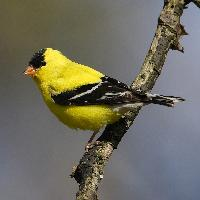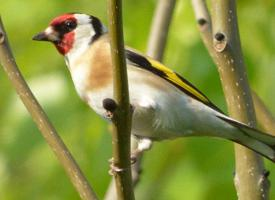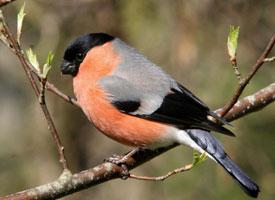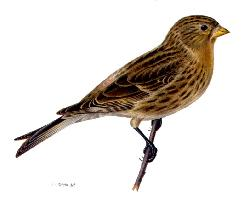
Description de l'animal
The American Goldfinch (Spinus tristis), also known as the Eastern Goldfinch or Wild Canary, is a small North American bird that is a member of the finch family. This delightful bird is highly recognizable and cherished for its vibrant plumage, melodic song, and acrobatic feeding habits. The American Goldfinch is not only a fascinating creature of the wild but also a favorite among birdwatchers and nature enthusiasts.Adult males in breeding plumage are particularly striking with their bright yellow bodies, contrasting sharply with black foreheads, wings, and tails. The wings are beautified further with white markings, which are visible during flight and while perched. In contrast, females and non-breeding males display a more subdued coloration, with olive to brown shades dominating their feathers, making them less conspicuous against their natural habitats. Both sexes, however, share a similar physical structure, characterized by a small head, conical bill adapted for seed eating, and a compact, robust body shape.
Measuring about 4 to 5 inches in length and weighing between 11 to 20 grams, the American Goldfinch is a diminutive bird with a wingspan that can reach up to 9 inches. Despite its small size, it is a resilient and adaptable species, thriving in a variety of environments, including meadows, gardens, orchards, and along roadways, predominantly across North America.
One of the most fascinating aspects of the American Goldfinch is its diet, which is almost exclusively vegetarian. It feeds on a diet rich in seeds, particularly favoring those of the aster family, such as thistles and sunflowers. The bird's specialized beak allows it to extract seeds with remarkable efficiency, a skill that is complemented by its ability to feed while hanging upside down from seed heads.
The breeding season of the American Goldfinch is notably later than that of many other birds, typically starting in late July to September. This timing is strategically aligned with the peak abundance of seed food sources, ensuring that the young have access to ample nutrition. Their nests are meticulously constructed, cup-shaped structures built by the females using plant fibers and spider silk, and often lined with thistledown, creating an incredibly soft and insulated environment for their eggs and chicks.
American Goldfinches are social birds, often seen in flocks, especially outside the breeding season. Their flight is distinctively undulating, consisting of a series of flaps and glides that make their movements through the air seem almost whimsical. The birds communicate with a variety of calls and songs, with the male's song being a long series of twittering and warbling notes, which are particularly melodious and complex during the breeding season.
As migratory birds, some populations of the American Goldfinch undertake seasonal movements, migrating from the northern parts of their range in Canada to the southern United States. However, many individuals within the United States are permanent residents, enjoying the relatively mild winters and abundant food supplies.
Conservation-wise, the American Goldfinch is considered to be of least concern, with stable and widespread populations. However, they are not without threats, as habitat loss and pesticide use can impact their food sources and breeding grounds. Efforts to conserve their natural habitats and promote environmentally friendly practices are essential in ensuring the continued survival and prosperity of this vibrant and beloved species.
In summary, the American Goldfinch is a remarkable bird, admired for its beauty, song, and fascinating behaviors. It plays a significant role in the ecosystems it inhabits, contributing to the pollination and dispersal of seeds. For many, the sight and sound of the American Goldfinch are synonymous with the changing seasons and the natural beauty of the North American landscape.
Carte de répartition

Animaux similaires
Nouvelles photos d'animaux
Top 10 des animaux
- Dolphin gull (Leucophaeus scoresbii)
- Diana monkey (Cercopithecus diana)
- Moustached guenon (Cercopithecus cephus)
- Galápagos tortoise (Geochelone nigra complex)
- Japanese macaque (Macaca fuscata)
- Stone loach (Barbatula barbatula)
- Russian tortoise (Testudo horsfieldii)
- Greek tortoise (Testudo graeca)
- Common flying dragon (Draco volans)
- Vendace (Coregonus albula)


